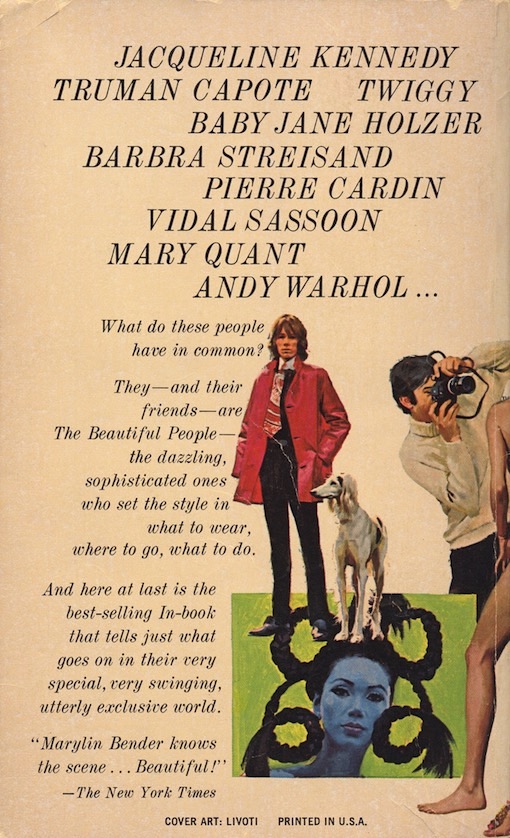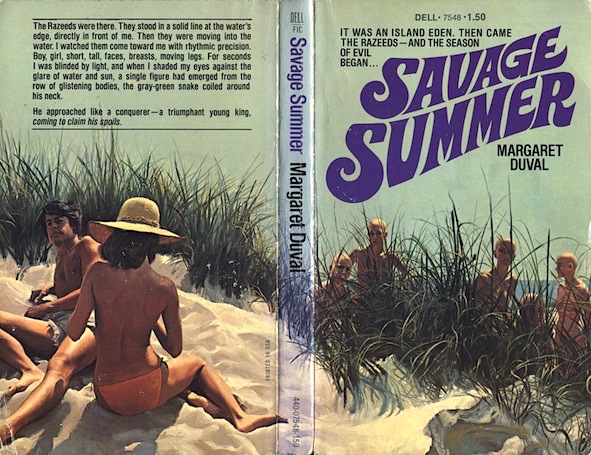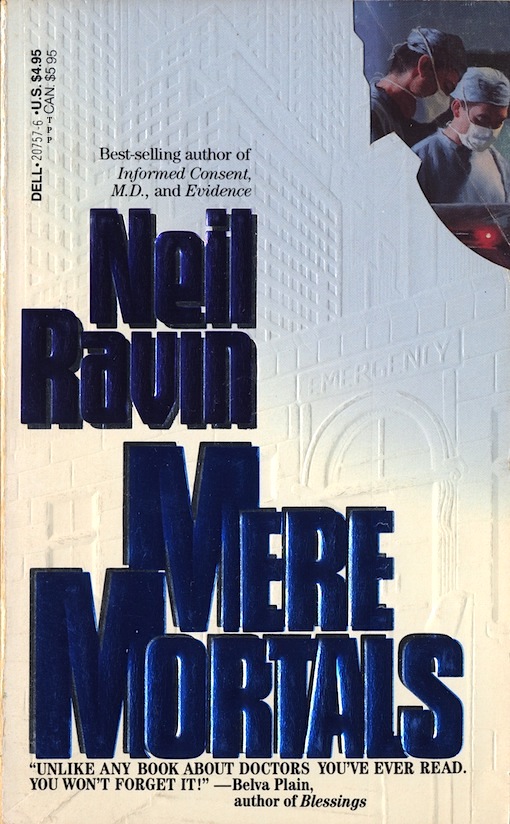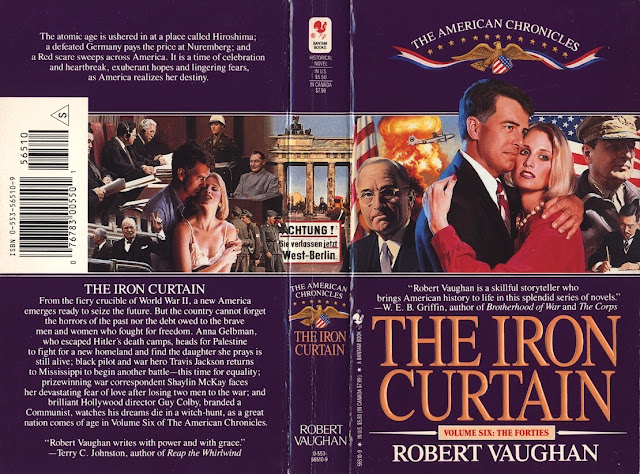I find it hard to believe that a 20th century illustrator who produced hundreds of
stunning paperback covers and an almost equal amount of advertising art could
fall so quickly into relative obscurity. But that's the unfortunate legacy of Victor Livoti, a supremely talented realist painter who passed away in 2009 with barely a hint of the kind of fanfare he deserved for being not only one of the most prolific practitioners in illustration, but also one of the absolute best.
Livoti's lack of public recognition is partly of his own accord: he never signed his paintings and he never exhibited them, and even his date of birth had been kept unawares until his obituary was posted (b. 1923). But what shouldn't be left unaware is his significant and substantial body of work, which represents some of the most attractive book cover art in all of publishing.
Livoti's lack of public recognition is partly of his own accord: he never signed his paintings and he never exhibited them, and even his date of birth had been kept unawares until his obituary was posted (b. 1923). But what shouldn't be left unaware is his significant and substantial body of work, which represents some of the most attractive book cover art in all of publishing.
After serving in the U.S. Army in WWII, Livoti took up studies at the National Academy School and at the Art Students League in New York City. He worked in advertising after that and then in the 1960's he started producing book covers for nearly all of the major paperback houses in the US; Avon, Ballantine, Bantam, Berkley, Charter, Dell, Fawcett, Harlequin, Jove, Pinnacle, Signet, St. Martin's, Warner and Zebra.
Livoti's style, now firmly established, was adhered to formal realism, yet marked by strong contrasts and a full range of values. Livoti was also pioneering the use of composite or montage illustration as beguiling book cover art. His paintings began boosting some of the biggest names in novel writing too, names such as
Desmond Bagley, Barbara Taylor Bradford, James Carroll, Leslie
Charteris, Len Deighton, John Dunning, Howard Fast, John Fowles, Paul
Gallico, Ben Haas, Burt Hirscheld, Jack Hoffenberg, Victoria Holt,
Evan Hunter, John Jakes, James Jones, Frank Kane, Herbert Kastle, Elmore
Leonard, Robert Ludlum, Erich Segal, Irwin Shaw, Wilbur Smith, Ross
Thomas, and Dan Wakefield. As far as authors go it doesn't get much
better than that unless you want to add James Baldwin to the list, whom
Livoti also produced a cover for.
BELOW is a loose but select chronology from my own book collection of Livoti's cover art so we can follow his amazing career path to its culmination in the 1990's. Also included is some brief information about each of the featured authors.
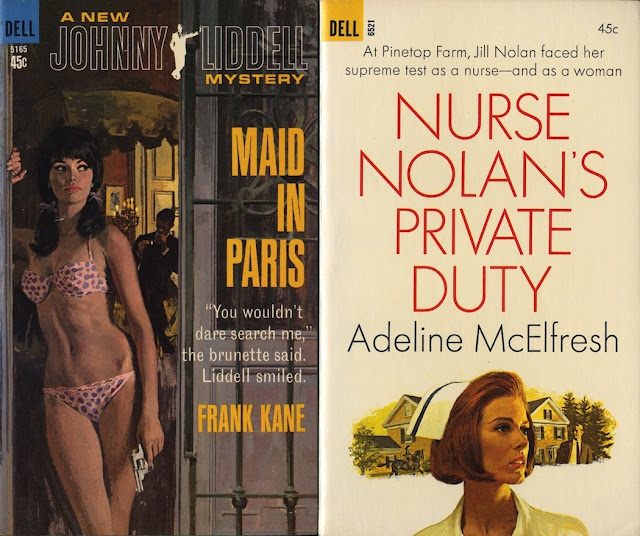 |
| CLICK ON IMAGE TO ENLARGE |
Maid in Paris and Nurse Nolan's Private Duty are the earliest paperbacks I've been able to obtain with Livoti's cover art. Both were published in 1966 by Dell. Maid in Paris is much sought after by vintage paperback collectors for its exceptional GGA ("Good Girl Art").
Maid in Paris: 'She was a French brunette, trained to kiss and kill, expert at both. Johnny had seen smooth operators before, but Andrea had the best connections he'd ever laid his eyes on... and she'd put them all at his service.'
Nurse Nolan's Private Duty: 'When Jill accompanied Carol Winston to Pinetop Farm, she knew her patient was in need of more than her medical skill. But Jill's training had not taught her how to heal an almost broken marriage...'
Frank Kane (1912- 1968) wrote 29 novels featuring his private investigator Johnny Liddell, and they proved so popular that even CBS approached him about adapting his character into a TV series. That prospect didn't quite work out but it did lead to him writing scripts for other TV shows like The Investigators, Mike Hammer and Special Agent 7. Before television he worked in radio writing scripts for The Shadow, Gang Busters, Call the Police and Nick Carter, Master Detective. Kane left this world too soon at only 56-years-old, but the mark he left on the world of P.I. fiction is indelible.
Indiana native and lifelong resident Elizabeth Adeline McElfresh (1918- 2015) specialized in medical novels. She wrote 56 of them in all, some under the pseudonyms Jennifer Blair, John Cleveland, Jane Scott and Elizabeth Wesley. For more than thirty years she was a society editor at the Vincennes Sun-Commercial newspaper before switching careers to become a public relations director at the Good Samaritan Hospital in Vincennes. The PR job would appear to be destiny calling.
 |
| CLICK ON IMAGE TO ENLARGE |
Here are two Livoti covers with matching styles and palettes, both painted in 1967. Livoti would eventually tighten up his style to appear even more photo-realistic, but there's certainly no discounting the exceptional quality of these earlier works.
Derek Marlowe (1938-1996) was an English playwright, screenwriter, painter and novelist, with nine novels to his credit. His debut, A Dandy in Aspic (Dell, 1967), was only a modest bestseller but today it's become highly regarded by spy fiction fans. It was filmed almost immediately upon publication by director Anthony Mann, who died unexpectedly during production.
A Dandy in Aspic: 'He was a double agent working both sides of the Iron curtain, turning dangerous double-crosses into deadly triple plays, trying to avoid the one dual role from which there was no escape--that of both murderer and victim.'
Getting asked to paint the cover of the first U.S. paperback edition of The Magus had to have been a source of pride for Livoti. Dell published their edition of John Fowles's landmark novel in January, 1967. It was then reprinted many times with the lovely lady-in-repose before Fowles revised his text and the book was given a new look by noted British artist Tom Adams.
The Magus: 'A modern Svengali, a young man thirsting to taste life, a lovely fated girl, bohemian London, and a beautiful but evil Greek island...'
 |
| CLICK ON IMAGE TO ENLARGE |
This is one of Livoti's first montage illustrations, a brilliant mashup of the fashion industry, produced for the cover of Dell's paperback edition of The Beautiful People by New York Times reporter Marilyn Bender. Note the removal of the magazine clippings from the final published paperback cover.
Dell published their paperback edition in 1968 after Bender's non-fiction book had already become a pop sensation in hardback. The hardback was subtitled: "A candid examination of a cultural phenomenon-- the marriage of fashion and society in the 60's." Dell's tagline pushed the limits of exaggeration by proclaiming: "Who they are and what they really do behind the golden doors of their scandal-ridden world." A not entirely inaccurate description, as it were, but what it reflects mostly is the kind of aggressive marketing strategy that paperback publishers engaged in routinely.
Famed designer/artist Paul Bacon, who produced the jacket art on the hardcover edition of Colonel Blessinton (1968), certainly has a lion's share of admirers, but I prefer Livoti's oddly juxtaposed illustration on Dell's 1970 paperback
version instead. I've dubbed this cover "a puppet in her hands".
Pamela Frankau (1908- 1967) wrote more than thirty novels in her all too brief lifetime, her first when she was but 19. She also wrote dozens of short stories, articles, and plays for both stage and radio and even an autobiography when she was still in her twenties. Colonel Blessington was the last thing she ever wrote. It was published posthumously with the help of Frankau's cousin Diana Raymond, who had to merge eleven manuscripts together to form a publishable whole. An audio tape recording made by Frankau and notes taken from hours of talks also contributed to Raymond's eventual success. The end result reads like modern day Shakespeare, but swift and suspenseful and themed by obsessive relationships, enigmas, riddles, disguises and flavorful gothic trappings. You will have to suspend your disbelief as you go along but the clues to the shocking denouement are all there even from the beginning.
Pamela Frankau (1908- 1967) wrote more than thirty novels in her all too brief lifetime, her first when she was but 19. She also wrote dozens of short stories, articles, and plays for both stage and radio and even an autobiography when she was still in her twenties. Colonel Blessington was the last thing she ever wrote. It was published posthumously with the help of Frankau's cousin Diana Raymond, who had to merge eleven manuscripts together to form a publishable whole. An audio tape recording made by Frankau and notes taken from hours of talks also contributed to Raymond's eventual success. The end result reads like modern day Shakespeare, but swift and suspenseful and themed by obsessive relationships, enigmas, riddles, disguises and flavorful gothic trappings. You will have to suspend your disbelief as you go along but the clues to the shocking denouement are all there even from the beginning.
'When Anita Gilroy fell in love with Harvey Blessington, the beautiful actress knew only that he had been a hero in the war, and now many years later was a brilliant, rising figure in politics. Perhaps she should have been content. But she had to know more--to pierce the mystery surrounding this proud, yet strangely haunted man and his final secret mission to Nazi-occupied Europe. Anita pried open the doors to the past, and entered a maze of intrigue, deception and horror...'
Brian Glanville's The Olympian (Dell, 1970), and Peter Kortner's Jim For Sale (Dell, 1973), both share the same pair of models even though there's a three year gap between each book. I've always wondered if Livoti was able to paint these back to back, or years apart, as each deadline neared?
Englishman Brian Glanville (1931- ) is a novelist, television writer, journalist and sports correspondent, with an experts bias towards European football (soccer). He's written more than twenty-one novels and too many non-fiction books to even mention. Notable Sports Illustrated columnist and personality Dr. Z (Paul Zimmerman) called Glanville "The greatest football writer of all time."
 |
| CLICK ON IMAGE TO ENLARGE |
Brian Glanville's The Olympian (Dell, 1970), and Peter Kortner's Jim For Sale (Dell, 1973), both share the same pair of models even though there's a three year gap between each book. I've always wondered if Livoti was able to paint these back to back, or years apart, as each deadline neared?
Englishman Brian Glanville (1931- ) is a novelist, television writer, journalist and sports correspondent, with an experts bias towards European football (soccer). He's written more than twenty-one novels and too many non-fiction books to even mention. Notable Sports Illustrated columnist and personality Dr. Z (Paul Zimmerman) called Glanville "The greatest football writer of all time."
The Olympian: 'His name was Ike Low. He started out as an 18-year-old kid with a knack for running. That was before a fanatical coach named Sam Dee saw him... before the headline-hungry reporters took him up... before the officials and the promoters started to woo him... before the celebrity-hunting women began to eat him alive... Ike Low was a man now, racing against the clock to the pinnacle of world fame--and the depths of personal corruptions...'
Before becoming a novelist, Peter Kortner (1935- 1991) worked in television as a producer, story editor and writer, with credits on Playhouse 90, Studio One, The DuPont Show of the Week, General Electric Theater, Hazel and The Farmer's Daughter. His career choices were probably influenced by his Austrian father Fritz Kortner, and his German mother Johanna Hofer, who were both distinguished actors and between the pair they amassed 147 film credits.
Jim for Sale: 'Jim had only one talent, but in the pay-and-play world of Hollywood, that talent was very much in demand. Aging movie goddesses, producers whose proclivities were kept in a closet, restless wives, repressed psychiatrists--Jim had what it took to fill their every need. Then Jim met Susan, and for the first time felt a love that was not for sale. The trouble was, Susan was not yet fifteen, which meant Jim was heading for a ride that could throw even an easy-riding midnight cowboy like him...'
From 1969 to 1973, Livoti produced seven paperback covers for Avon's popular novelist Jack Hoffenberg. As on A Hero for Regis, each book has a descending montage situated on the left side. These were, in essence, prototypes of what eventually would become Livoti's predominate illustration template, the wraparound montage (or collage).
Jack Hoffenberg was born in 1906 and attended the University of Maryland and then the Maryland Institute College of Art, where he learned to sculpt under famed sculptor Reuben Kramer. After serving in the WWII as a major Hoffenberg opened up his own successful advertising agency in Baltimore. In the 1950's he relocated to Southern California and it was there at age 53 that he began to write fiction. He completed ten novels, each one epic in length and meticulously researched for period accuracy, before being struck down in 1977 by an unfortunate illness.
Jack Hoffenberg was born in 1906 and attended the University of Maryland and then the Maryland Institute College of Art, where he learned to sculpt under famed sculptor Reuben Kramer. After serving in the WWII as a major Hoffenberg opened up his own successful advertising agency in Baltimore. In the 1950's he relocated to Southern California and it was there at age 53 that he began to write fiction. He completed ten novels, each one epic in length and meticulously researched for period accuracy, before being struck down in 1977 by an unfortunate illness.
A Hero for Regis: 'One of the truly big novels of our time, this is the revealing story of Southern small-town life. It is a life of lust, of violent hatreds between rich and poor, black and white, a life of corruption spawned by an obsession with power.... it spans two continents, a world war, and the lives of men and women swept into the turmoil of overwhelming change.'
At first glance I thought my copy of Gary Blumberg's Hit Woman had been marked up by a red crayon, but a closer look at Livoti's cover art reveals otherwise: note the red lipstick tube lying on the table. In Livoti's preliminary sketch, an oil on board approximately 12 x 17 inches, the lipstick tube was yet to be added.
Hit Woman was published by Dell in 1975. The tagline on the back reads: "The novel that drags The Godfather kicking and screaming into the 1970's." Blumberg also wrote a series of mafioso inspired men's adventure novels under the pseudonym Michael Bradley, headlined as Adrano For Hire.
'When a Daughter stops honoring her father and starts planning to hit him where it hurts; When a Wife trades in her pasta pot for a pistol; When a Godmother steps into a godfather's shoes and finds that they fit her just fine, you know that the men of the Mafia are about to be handed a proposition that they simply can't turn down (though they wish they couldn't!)...'
'The Candywine Development: The electrifying story of a small offshore Caribbean island that suddenly begins to tick with unknown terror, setting in motion a series of violent undercover treacheries involving the major powers of the world, the Mafia, and a matchless pair of lovers capable of the deadliest espionage of all...'
"A branch of the CIA has been hit and wiped out. The only survivor knows that the order for the massacre has come from within the Agency itself. His only hope of staying alive is to run. Now even his trusted friends become enemies, and he's adrift in a bizarre espionage nightmare of insidious treachery and high treason. His cod name is Condor--and his days are numbered..."
Livoti's scene-specific illustration on The Cry of the Halidon (Dell, 1975) makes one anxious to read the novel, so we can find out just how this handsome couple ended up alongside the banks of a pouring tropical river, and armed for bear.
"Somewhere in the primitive, unmapped interior of the Caribbean island of Jamaica lies the secret to fabulous wealth and power, the key to controlling the world. You have the assignment of uncovering that secret before anyone else. You have the backing of a huge, international combine but you discover the men under your command strangely unskilled, the weapons you carry almost useless against the savage cunning of a native tribe that calls itself "the Halidon." When you move deeper into the trackless jungle, you find yourself fighting not one but two unseen enemies as you move closer to the mind-boggling secret, to the real meaning of The Cry of the Halidon."
Robert Ludlum (1927- 2001) used the pseudonym Jonathan Ryder only twice in his career. Under his own byline he wrote twenty-five novels, and it is estimated that there may be as many as 400 million copies of his books still lying around. He also wrote the bestselling Jason Bourne spy series which to date have spawned four successful films. Those films, and the use of his name on books written by others, have helped his estate build an estimated one billion dollars in net worth.
Livoti produced several excellent covers for novelist Elmore Leonard (1925-2013) including this moneyed one for The Hunted, which Dell published in 1977.
"Suddenly Al Rosen's quiet existence took a dive. Hotels burned down around him. Cars crashed through sidewalk cafes just to nail him. Snipers tried to pick him out of crowds, and someone kept rigging his car with plastic explosives. But who? And why? Up to now, Al's answer had always been to run. To run from his mysterious past--and to go right on running into the future. But this time he couldn't run, and even his best friends won't tell him why."
Back in the 1980's I attended an Elmore Leonard book signing at the Tattered Cover in Denver. The Edgar Award winner spoke openly about his personal writing philosophies, which at the time were undocumented. In 2001 he made them officially known in a New York Times essay titled "Ten Rules for Good Writing." That became the basis of a very slim, overpriced, handsomely illustrated book in 2007.
Here are those rules in their base form:
- Never open a book with weather.
- Avoid prologues.
- Never use a verb other than said to carry dialogue.
- Never use an adverb to modify the verb "said"... he admonished gravely.
- Keep your exclamation points under control. You are allowed no more than two or three per 100,000 words of prose.
- Never use the words "suddenly" or "all hell broke loose."
- Use regional dialect, patois, sparingly.
- Avoid detailed descriptions of characters.
- Don't go into great detail describing places and things.
- Try to leave out the part that readers tend to skip.
Savage Summer was written by Patricia Colbert Robinson and Nancy Stevenson under their pseudonym Margaret Duval. The two best friends also wrote two other mysteries but Livoti produced the cover art only on this one, which Dell published in paperback in 1976. It's a perfect fit though for the novel's rather strange, sexually charged atmosphere--and no, those aren't manikins posed behind the grass!
Patricia Robinson (1929- 2001) was a distinguished Charleston, South Carolina, author, poet, actress and playwright, with over fifteen plays to her credit. Of her seven novels, mostly mysteries, four were written unaccompanied, and all are set in or around her beloved home town of Charleston.
Ferdinan B. "Nancy" Stevenson (1922-1998) was the first woman to hold statewide elected office in South Carolina, as Lieutenant Governor (1979-1983). She campaigned under the slogan, "not one of the good old boys!" In office she became an advocate for accountability, and helped initiate a toll-free hotline so citizens could get in touch with state agencies. Her political career was nearly derailed though when it was learned that she had co-written a lurid novel about island vacationers being stalked and manipulated by a ritualistic, bald-headed tribe of sexualized weirdos. The novel of course was Savage Summer. Her opponent, State Representative Horace Smith, tried to raise questions about her supposed lack of morals because the novel not only contained inappropriate sexual material but references to certain South Carolinian's as "culture-starved, tater-popin', egg-suckin' rednecks." Mrs. Stevenson won election by 176,867 votes to Mr. Smith's 154,396. Apparently, South Carolinian's like their novels just as raunchy as the rest of us.
 |
| CLICK ON IMAGE TO ENLARGE |
Milton Lesser (1928- 2008) wrote an incredible amount of science fiction under his own name and various pseudonyms before legally adopting the name Stephen Marlowe. However his best writing was as Marlowe, including the WWII thriller The Valkyrie Encounter (Jove, 1978), and a slew of other novels starring his globe-trekking private investigator Chester Drumm. Those early Drumm novels, published mostly as Gold Medal originals, had cover art supplied by famed illustrators Ernest "Darcy" Chiriaka, Robert McGinnis, Barye Phillips and Stanley Zuckerberg. Now Victor Livoti can be added to that distinguished list of cover providers (Note: The stepback illustration was painted with gouache, and the man with the eye-patch is Livoti's good friend and fellow artist Don Stivers, who frequently posed for him).
"Codename Valkyrie. The message would signal the death of Adolph Hitler and the end of the Nazi regime. The plan was so good, it seemed nothing could stop it from succeeding. But the plotters had no way of knowing that Hitler's enemies would sabotage their plan. Two men, disguised as Nazis, were making sure that Operation Valkyrie never reached its target. Their government had sent them to save Hitler's life--save it so they could destroy him themselves."
If you've never read The Edgar Award winning crime writer Ross Thomas, you should, and Chinaman's Chance (Avon, 1979) is as good a place to start as any, unless you happen to run across The Fools In Town Are On Our Side (1970), which some folks argue is Thomas's best novel. That paperback, also published by Avon, has a pretty good cover illustration by Norm Eastman, but Livoti's character specific composite on this paperback is just as righteous.
"It was a million-dollar con game with a missing blonde named Silk in the middle. Playing it to the hilt were two elegant rogues: Quincy Durant, a wire-hard adventurer with a world of experience from Bangkok to L.A.; and his enterprising accomplice, Artie Wu, the pretender to the throne of imperial China. A Malibu midas proffered a staggering fee to find Silk. But there was a catch: a bundle of cold-blooded henchmen were looking too. And if they found her first, all the muscle in Venice Beach couldn't put her back together."
Wilbur Smith rarely needs an introduction, even casual readers of fiction seem to know his name and brand. Born in 1933 in Northern Rhodesia (now Zambia), Smith was raised on his father's African cattle ranch. His tough, hardworking father didn't approve of books as entertainment but his mother did, and she helped instill in her son a passion for literature. Smith's English Master at boarding school was also a key motivator for the boy. Their combined influence resulted in Smith writing 38 bestselling novels including this one, Hungry As The Sea (Signet, 1981), an absolutely terrific maritime adventure that spans both Antarctica and America. This paperback also boasts one of my favorite cover paintings by Victor Livoti, a gem of a collage that is as efficacious as it is seductive.
"A hold-your-breath suspense story of life and death, of love and hate, of noble gestures and venality... you won't be able to put it down until you're finished!" --- Colorado Springs Gazette.
 |
| CLICK ON IMAGE TO ENLARGE |
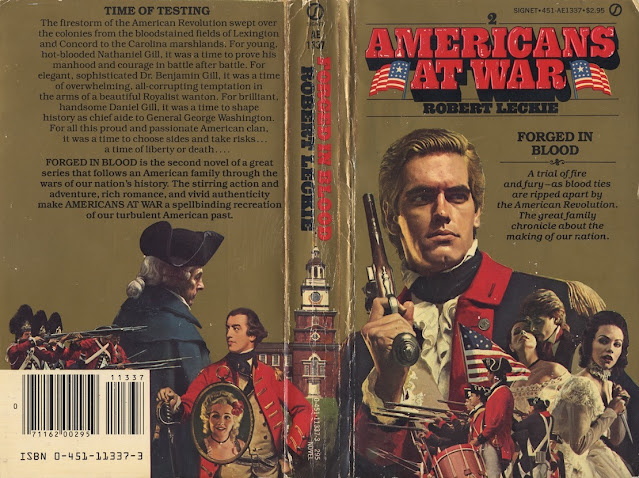 |
| CLICK ON IMAGE TO ENLARGE |
Robert Leckie (1920- 2001) wrote more than 40 non-fiction books on US military history, spanning the French and Indian War to Desert Storm. His 1957 memoir, Helmet For My Pillow, formed the basis of the 2010 HBO series The Pacific. He also wrote five novels, three of them part of an Americans At War Early American historical series, starting with The Bloodborn (Signet, 1981), and its direct companion, Forged In Blood (Signet, 1982). Livoti's wraparound collages for these two paperbacks appear to be relatively accurate in their period detail, which no doubt pleased the history-stickler Leckie. They definitely pleased me!
The Bloodborn: "Rachel--She and Jed Gill played together as children--until the act of love made them man and woman. But Rachel vanished from Jed's life in a night of Indian attack, and he did not want even to imagine what had happened to her. Redbud--A beautiful Indian girl on the very brink of womanhood, and the sister of the brave who made Jed his blood brother. She was forbidden to Jed--but was as irresistible to him as he was to her. In a struggle that swept Colonial America from the settlements of New England to the battlements of Queberc, the fate of the continent hung in perilous balance. In captivity to an Indian tribe, torn between this new life and his old, Jed Gill was at a crossroads of his own..."
Forged in Blood: "Nathaniel Gill did not want to believe his ears when he heard the verdict of the military court: "You are guilty of desertion--and sentenced to death by firing squad." How could his own fellow soldiers kill him after he had fought so bravely and well at Lexington and Concord, at Bunker Hill, at Valley Forge, in victory and defeat? How could his superiors not take his word that he'd had permission to visit the woman he loved for a few nights of well-earned peace and pleasure? But now he had to believe what was happening, as he saw the muskets leveled at him, and heard the officer's voice loud and clear in the still air: Ready. Aim. FIRE..."
Forged in Blood: "Nathaniel Gill did not want to believe his ears when he heard the verdict of the military court: "You are guilty of desertion--and sentenced to death by firing squad." How could his own fellow soldiers kill him after he had fought so bravely and well at Lexington and Concord, at Bunker Hill, at Valley Forge, in victory and defeat? How could his superiors not take his word that he'd had permission to visit the woman he loved for a few nights of well-earned peace and pleasure? But now he had to believe what was happening, as he saw the muskets leveled at him, and heard the officer's voice loud and clear in the still air: Ready. Aim. FIRE..."
How can anyone resist these Livoti painted peepers? Certainly not me; I bought this copy of A Woman of Fortune as soon as saw it in a used bookshop, and, had I seen it in 1981 when it was first published by Signet, I would have an even better copy preserved for posterity.
'Promises and Fulfillment. Mark Cardozo promised Sabine a position as his wife at the very summit of old-money Jewish aristocracy of New York--where "Our Crowd" formed a tightly closed circle of wealth and culture and influence. Matt Ryan promised Sabine a world of danger and excitement if she took him as a lover and followed him to the hot spots of a globe exploding into war. Bernie Ross promised Sabine the glamour and money of movieland if she allowed herself to be his "good luck piece" in the ruthless power games he played. How could Sabine say not to any of them--hungering as she did for all that life had to offer...?'
Will Holt (1929- 2015) wrote only one other novel besides this, the storm ravaged thriller Savage Snow (1980). He worked primarily as a musical playwright but he was also an accomplished singer/songwriter and a key figure in the American Folk Music scene of the 1950's and 60's. The hit songs Lemon Tree, and Raspberries, Strawberries, were both his, but they were championed by other performers (Kingston Trio, Peter, Paul and Mary, and The Seekers). Holt's son Courtney has said that his father's music influenced a lot of people: "Dad always worked behind the scenes inspiring other people, which I think is really cool." It looks to me like Courtney's dad also inspired our Mr. Livoti.
 |
| CLICK ON IMAGE TO ENLARGE |
Larry Collin's spy novel Fall From Grace (Signet, 1986) is a tough book to recommend even though I consider it to be a real page turner. The story takes place in 1944 and follows a courageous young Englishwoman and a French resistance fighter who become embroiled in a complicated plot to deceive Germany into believing that the D-Day invasion will take place at Calais instead of Normandy. In reality they're merely pawns in a dangerous game of deceit and double-deceit involving both British Intelligence and the Gestapo. Of course it all ends badly, contradicting my optimist belief that our heroes would somehow, someway, persevere. Livoti's captivating stepback montage did manage to lift my spirits though, and for that I'm forever grateful.
Larry Collins (1929- 2005) was a Yale graduate who co-authored four books with French writer Dominique Lapierre. Their first was the famous Is Paris Burning?, which was filmed in 1966. Fall From Grace was also filmed, but only for television (1994), however, it did boast a strong international cast which included, among others, Michael York, James Fox, Richard Anconina, Patsy Kensit and Tara Fitzgerald.
"Larry Collins seems to one of the writers born in a trenchcoat." --- Los Angeles Daily News.
Larry Collins (1929- 2005) was a Yale graduate who co-authored four books with French writer Dominique Lapierre. Their first was the famous Is Paris Burning?, which was filmed in 1966. Fall From Grace was also filmed, but only for television (1994), however, it did boast a strong international cast which included, among others, Michael York, James Fox, Richard Anconina, Patsy Kensit and Tara Fitzgerald.
"Larry Collins seems to one of the writers born in a trenchcoat." --- Los Angeles Daily News.
The front corner of the medical melodrama Mere Mortals (Dell, 1990) was die cast to cleverly conform to the shape of a hospital building. Livoti's stepback illustration can be glimpsed just underneath. Of interest here is the gray-haired fellow near the top, who Livoti repurposed from Chinaman's Chance, though I'm pretty sure the rest of the elements are new to this montage.
"At Whipple, doctors and nurses battle to keep patients from checking into the ECU (Eternal Care Unit). Sometimes they battle each other. Sometimes they even fall in love."
Neil Ravin is an endocrinologist and the author of five novels about hospital drama. His books have been mostly well received and some are even beloved by readers. It might be safe to say that Dr. Ravin has a good "readside" manner.
Bantam published Dream Weavers in 1992 in both trade and mass-market paperback formats. The design for each was identical. The flower drawing is credited to the Japanese publishing entity Kyoto Shoin, Inc., but the beautiful stepback composite is all Livoti.
"Dreamweavers: The year is 1907 and Rose Jefferson marries her image of the ideal man. He is handsome, devoted, and too rich to covet Rose's great fortune. But for Rose love will always be the ultimate betrayer. The bitter lessons she learns will forge her vision of the future: a Rose too powerful ever to be hurt again. Blind Ambition: As the iron lady who heads a vast business empire, Rose pushes all before her to create the world's first credit card. But people cannot be controlled so easily; least of all her idealistic brother, Franklin, his beautiful French-born wife, or Rose's son, Steven, who will not wait his turn to inherit the dream. Deadly Vengeance: Cassandra Jefferson was born of love, educated by tragedy, and deprived of more than her inheritance. She will use Rose's vision against Rose's own son to attempt the destruction of the destroyer--but in the process, will she shatter her own dreams?"
Montreal born Philip Shelby (1950- ) wrote nine novels, all family sagas or thrillers, before relocating to California to write screenplays for Hollywood. His film credits now include Survivor (2015), a political thriller starring Pierce Bronson and Milla Jovovich, and Mechanic: Resurrection (2016), a big-budgeted, Jason Statham action-thriller.
 |
| CLICK ON EACH IMAGE TO ENLARGE |
Retired Army officer Robert Vaughan has been
writing books for almost sixty years. He sold his first novel at age 19, and his output now exceeds 500 books. That's an astonishing fact if you
stop and think about it (and to think I struggle just to get a paragraph written on my blog). Vaughan writes westerns primarily, but he's also written novels in most every other genre except perhaps
the fantastics, and under a variety of pseudonyms. His epic, scholarly and quite entertaining fiction series, The American Chronicles, with its volumes published between 1992 and 1996, may in fact be the last set of actual cover art that Victor Livoti produced before retiring himself. Oddly enough, Volume One's cover art was erroneously credited to "George Busch", which sorta sounds like an inside joke because George H. Bush was then President of the United States. In Volume Two the spelling was amended to read "George Bush", but after that each volume was properly credited to either "Vic Lavoti" or "Vic Livoti." Now the truth is, there really was a book cover illustrator named George Bush who worked for Bantam back then, so in all honesty I''m thinking that these gaffes were really nothing more than just editorial oversight of which every publisher is guilty of from time to time.
The American Chronicles volumes are as follows:
The American Chronicles volumes are as follows:
1. Dawn of the Century (Bantam, Februrary, 1992)The ninth and last book in the series is titled Flower Children and it was published in 1996 by Bantam, but the cover art was supplied by Bob Larkin (pictured below). Why Livoti didn't provide for V. 9 is not known, but Bob, the consummate professional, certainly met the art director's expectations by replicating to perfection the same basic montage composition (sans a full wraparound) that Livoti formulated on all of the previous volumes.
2. Over There (Bantam, June, 1992)
3. The Lost Generation (Bantam, September, 1992)
4. Hard Times (Bantam, March, 1993)
5. Portals of Hell (Bantam, December, 1993)
6. The Iron Curtain (Bantam, May, 1994)
7. The Cold War (Bantam, January, 1995)
8. The New Frontier (Bantam, November, 1995)
 |
| CLICK ON IMAGE TO ENLARGE |
I'M STILL searching for paperbacks published after 1995 that have covers by Victor Livoti, but so far in my local bookshops I haven't found any. My goal is to collect his very last cover, and of course I'm still searching for his first cover too, which sometimes feels like an arduous if not impossible task. But the "hunt" is really what makes collecting fun, and it never wanes unless you get reined in by your spouse, or you happen to develop hoarder's remorse.
[Originally posted in January of 2014. © Revised in May 2018.]

